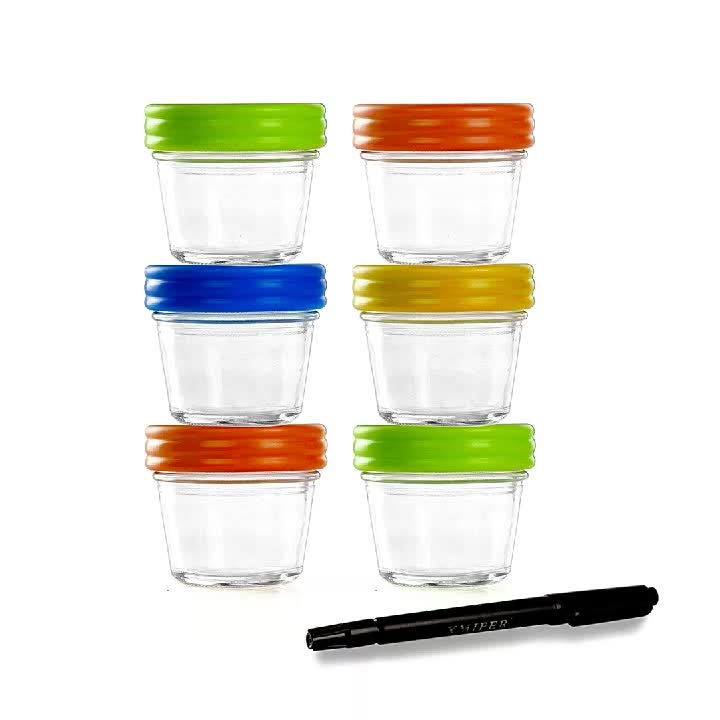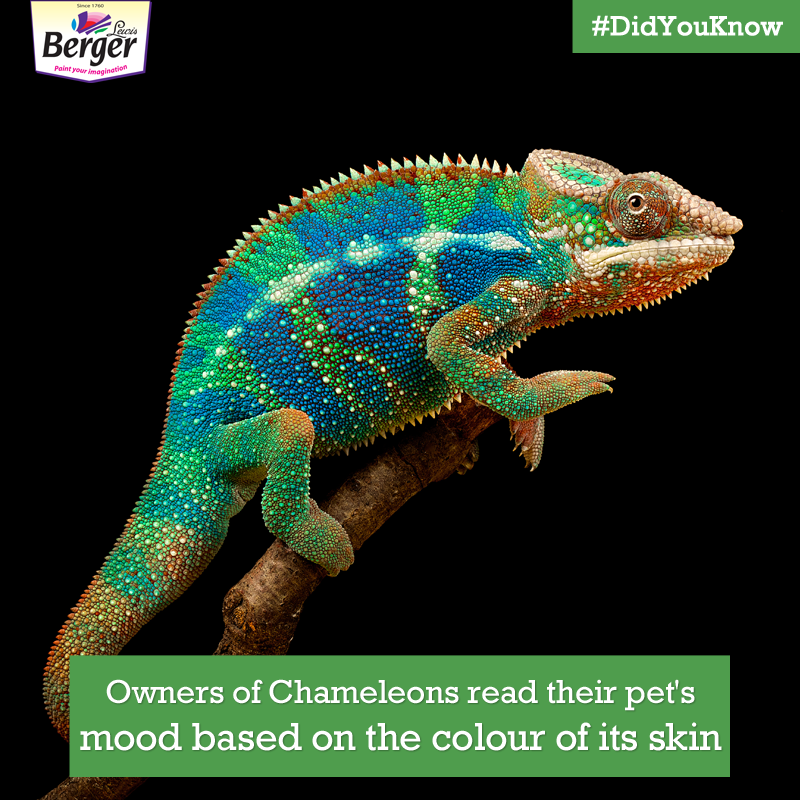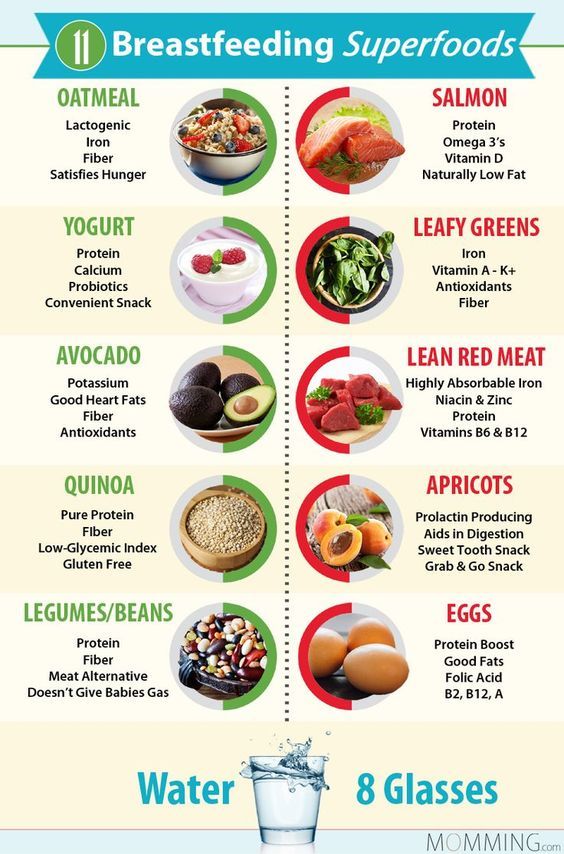Glass baby food jars for freezing
How to Make and Freeze Baby Food in Jars
Share This
F T P E
February 11, 2014 Preserving Recipes, Recipes
Making your own baby food is great way to ensure your baby is eating the freshest locally grown fruits and vegetables. It is quite simple to do and before you know it you’ll have a freezer stocked with your local bounty.
Once your pediatrician has suggested it’s time to introduce solid foods, which is usually around 6 months of age, you’ll want to determine which foods to start with. Common first foods are carrots, apples and sweet potatoes. Here’s a list of suggested first foods. After your baby has been eating solid foods for a few months you may want to try introducing some other foods such as, broccoli, avocados and cauliflower.
Three basic ways to prepare baby food:
Steam:
Certain produce tends to respond better to steaming, such as apples, pears broccoli, and plums. Put an inch or so of water in a pot, add in the produce, cover and steam until soft.
Roast:
Utilizing your oven to roast is a good method for cooking carrots, sweet potatoes, winter squash and beets. Chop food into small/medium pieces, or roast whole in an oven at 325 degrees.
Raw:
Foods like bananas & avocados are perfect in their raw state. Once ripe, just mash with a potato masher. For a smoother consistency you can puree with a blender or an immersion blender.
Here’s how to make a basic carrot puree for your baby
- Rinse carrots in water.
- There’s no need to peel carrots, especially if you are using organic carrots. The vast majority of the nutrients in carrots are contained in the peel! Find out more about whether or not to peel produce for your baby here.
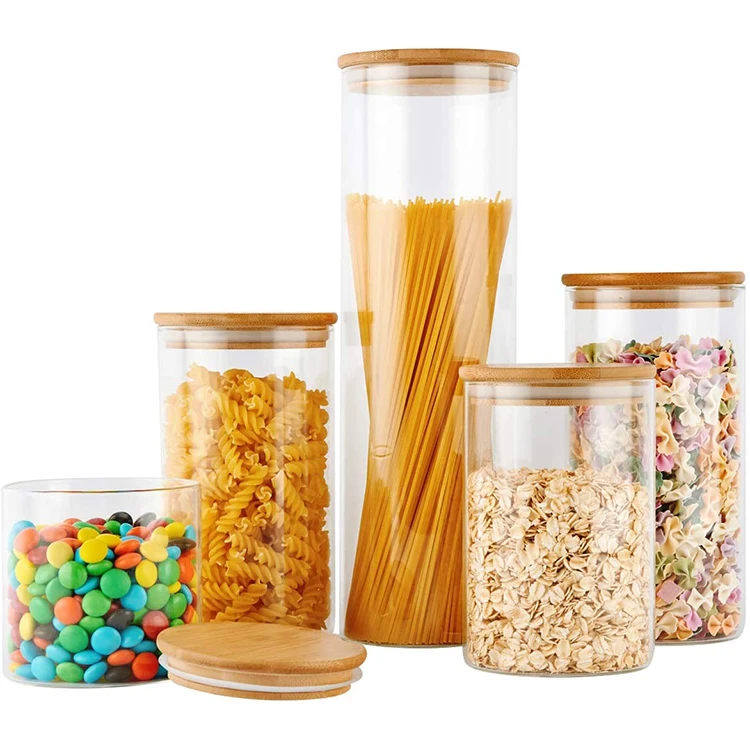
- Heat the oven to 325 degrees.
- Slice the carrots into strips.
- Place the carrots in foil and wrap them up, creating a foil pocket for the carrots to cook in.
- Place your foil pockets on a cookie sheet and place in the oven.
- Cook until the carrots are soft. (45-50 minutes)
- Place the cooked carrots into a large bowl and use a immersion blender to puree, add water as needed. If you don’t have an immersion blender, you could use a food processor or blender.
- Once the puree is smooth spoon into 4 ounce jars, top with lids and freeze.
- Here’s more recipes for carrot baby food.
Here’s how to make a basic broccoli puree for your baby
- Rinse broccoli in water.
- Cut broccoli florets into similar sizes.
- Fill a medium pot with about an inch of water.
- Add broccoli to pot and cover.
- Simmer broccoli until soft and bright green. (5 minutes)
- Add broccoli to a large bowl, reserving the cooking liquid.

- Use an immersion blender to puree, add cooking liquid as needed.
- Once puree is smooth spoon into 4 ounce jars, top with lids and freeze.
- Here’s more recipes for broccoli baby food.
Tips:
- Do not overfill jars when freezing. Allow enough headspace for the expansion of your product. Read our post about how to freeze in jars for more important tips.
- Do NOT try to microwave a frozen jar. Thaw jars in the fridge or on the counter, if you are able to monitor them.
- Use jars that are appropriate for freezing food. Jars that do not have shoulders are the easiest because the contents can expand upward in the jar during freezing.
- We recommend the 4 ounce Regular Mouth Tapered Jars, or Ball’s 4 ounce Quilted Crystal. However, you could also use our 2 or 4 ounce Straight-Sided Jars. We’ve pictured both the Tapered and Straight-Sided jar styles below.
- If you’ve been blessed with multiples and wish to freeze in larger volumes to split after thawing, the 8 ounce Widemouth Jars would work well and they’d stack nicely in the freezer.

Pictured from left to right – 4oz Regular Mouth Tapered Jars 70G CT, 4oz Straight-Sided 58CT
Want to learn more about making your own baby food? Here’s a great resource for baby food recipes.
7 Best Baby Food Storage Containers (2022 Reviews)
Whether you’re making your own baby food or storing store-bought baby food, you want containers that will keep it fresh and safe from harmful chemicals, prevent freezer burn, and be easy to use and clean.
As baby food storage containers come in all shapes, sizes, prices, and formats, it can be challenging to know which containers are worth buying. But we’ll make it easy for you. We’ll explain the advantages of the different types of food storage containers and how to use them to store your baby food safely.
We’ll even compare the top products and give you our reviews of the best baby food storage containers for storing and freezing homemade baby food purees for use at home or on the go.
Our Top Picks
We love honesty! Mom Loves Best earns a commission through the following hand-picked links at no extra cost to you.
Image
Model
Product Comparison Table
Features
Best Glass Storage
WeeSprout Glass
- Measurements on the container
- Set of 12
- High-grade, food-safe glass
Check Price
Best Budget Pick
Sage Baby
- Lots of jars for a good price
- BPA-, phthalate-, and lead-free
- Reusable
Check Price
Best Freezer Tray
Kiddo Feedo
- Includes baby food e-cookbook
- Silicone is durable
- Tight clip-on lid
Check Price
Best Plastic Containers
Tovla BPA Free Plastic
- Travel size
- Attached, leak-proof lid
- BPA-free plastic
Check Price
Best SnapLock Containers
OXO Tot Baby Blocks
- Includes carrying tray
- Extra-secure lids
- High-quality materials
Check Price
Best Food Pouches
Wee Sprout Reusables
- Extra wide, double-zipper bottom
- Eco-friendly materials
- Multiple sizes available
Check Price
Best Large Containers
Collapsible Silicone
- 3 large sizes to choose from
- Collapsible design
- Airtight lids
Check Price
Table of Contents
- Our Top Picks
- The Best Baby Food Storage Containers of 2023
- Types of Baby Food Storage Containers
- How to Store Baby Food Safely
- Storing Homemade vs.
 Store-Bought Food
Store-Bought Food - Making Your Own Baby Food
- The Bottom Line
The Best Baby Food Storage Containers of 2023
These are our favorite baby food storage containers.
1. WeeSprout Glass Baby Food Storage Containers
Best Glass Baby Food Storage
View on Amazon
View on Walmart
If you are making baby food for the first time, this glass container set will be a great purchase. We like that it takes the guesswork out of storing baby food and has everything a beginner needs. Glass is also one of the safest materials to work with because it is so easy to clean and sterilize.
Choose from a set of 12 4-ounce or eight 8-ounce microwaveable, dishwasher-safe jars. Each jar includes measurement markings on the side so you can portion your baby’s meals and track how much they eat.
All of the products are 100% BPA-, phthalate-, and PVC-free, so you don’t have to worry about your little one being exposed to questionable chemicals.
These glass baby food storage containers work best for small-batch baby food prep. If you prefer to make large batches of homemade baby food, you may want to purchase several sets.
Pros
- Set includes 12 4-ounce or eight 8-ounce containers.
- Measurement markings on the container.
- Microwave and dishwasher safe.
Cons
- Jars may crack if introduced to sudden temperatures changes.
2. Sage Glass Baby Food Storage Containers
Best Baby Food Storage Jars
Check Price
Baby food has traditionally been stored in tiny glass jars because jars are portable and strong, and they hold a tight seal.
We searched for the best large-quantity, high-quality set of baby food storage jars to use at home and found this great set from Sage.
The 12 reusable 4-ounce jars are made of glass, are safe to use in the microwave and freezer, and come with tight-sealing lids and a marker.
With 12 jars for one great price, this is an excellent option for moms on a budget who want to make baby food in bulk.
Pros
- Lots of jars for a good price.
- High-quality glass material.
- Reusable.
- BPA-, phthalate-, lead-, and PVC-free.
Cons
- Takes up storage space.
- Prone to breakage.
3. Kiddo Feedo Freezer Tray
Best Freezer Tray for Baby Food
Check Price
Silicone is the king of the freezer! Foods won’t get stuck in silicone molds and will pop out easily. Silicone is washable, stain-resistant, and won’t scratch or scuff over time.
Freezing larger batches of baby food is a popular way to cut down on time in the kitchen for busy moms. This silicone freezer tray makes it easy to make baby food in bulk, then store it in the freezer to use as needed.
Each tray comes with nine food pods that can hold up to 2.5 ounces of food. Each pod has individual measurement markings and a unique clip-on lid that prevents spills, protects against freezer burn, and makes stacking easy.
Purchase several trays in different colors and freeze different food types in different-colored trays to easily decipher which food you’re grabbing at a glance.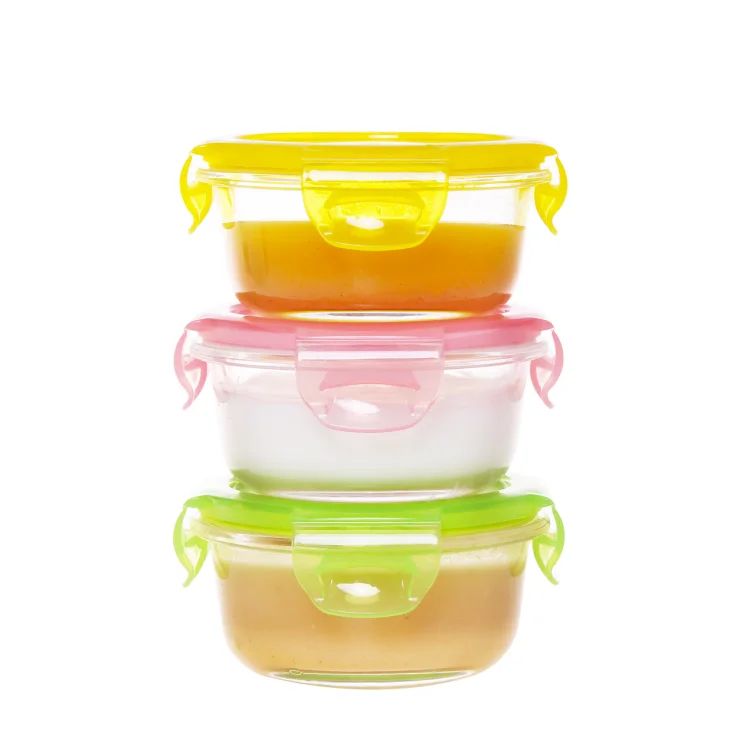 Once your baby food is frozen, you can leave it covered in the trays in the freezer and pop out a serving whenever you need one. Or transfer the frozen food to zip-top bags so you can reuse the tray.
Once your baby food is frozen, you can leave it covered in the trays in the freezer and pop out a serving whenever you need one. Or transfer the frozen food to zip-top bags so you can reuse the tray.
Our favorite thing about this freezer tray is the downloadable 47-page e-cookbook and instruction guide that comes with your purchase. If you are nervous about storing baby food in the freezer, the cookbook can give you some ideas on the best recipes to use.
Pros
- Includes baby food e-cookbook.
- Silicone is durable.
- Tight clip-on lid.
Cons
- Strong silicone scent.
4. Tovla BPA-Free Plastic Baby Food Containers
Best Plastic Baby Food Containers (BPA Free)
Check Price
Plastic containers have a lot of positives. They are generally less expensive than glass containers, easier to purchase in a wide variety of sizes, and fairly indestructible if your child gets a hold of them.
However, many concerns have been raised about the types of plastics used to make baby food storage containers. Low-quality plastics can actually leach harmful toxins and chemicals into your food and your baby’s body (1).
Low-quality plastics can actually leach harmful toxins and chemicals into your food and your baby’s body (1).
One of the reasons we like this set from Tovla is because their plastic containers are food-grade safe and free of BPA. If you are a health-conscious mom who wants the convenience of plastic without the fear, this set may be just the thing.
This is the best set for on-the-go moms who may sometimes want to dispose of their baby food storage containers while they are out without breaking the bank. But don’t worry, they’re recyclable!
Each of the 50 plastic containers in the set holds approximately 3 ounces of food. The attached lids hinge and snap closed, meaning you will never lose a lid again.
Pros
- Travel size.
- Attached leakproof lids.
- BPA-free plastic.
Cons
- Not microwaveable.
- The thin plastic can be squashed easily.
5. OXO Tot Baby Blocks
Best SnapLock Baby Food Containers
View on Amazon
View on BuyBuyBaby
View on BedBath&Beyond
View on Walmart
View on HomeDepot
Sometimes you need to take your baby food on the go.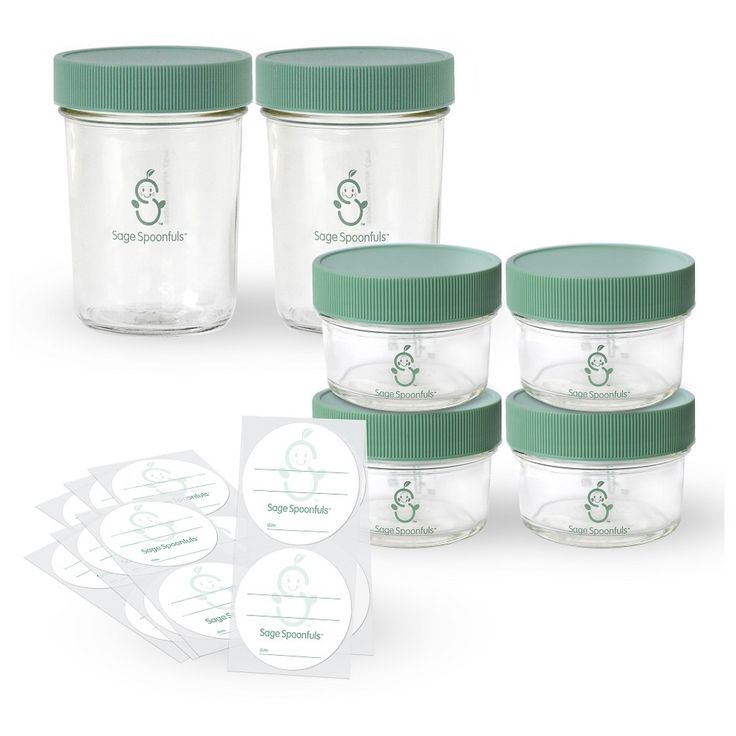 Whether you are traveling to another state or just down the street, containers with snap lids add more security so your baby food stays right where it is supposed to be.
Whether you are traveling to another state or just down the street, containers with snap lids add more security so your baby food stays right where it is supposed to be.
We are big fans of these special “baby blocks” storage containers, available in multiple sizes in a single set. They have a range of high-quality features, including BPA-free plastic and airtight, watertight, leak-proof snap lids.
They are freezer and microwave safe, making it even more convenient to feed your baby. What we most appreciate is the included carrying tray.
The carrying tray is made of plastic and holds all the containers. This means you can safely transport all the baby food you need without having to stuff jars in a diaper bag or have them floating about your car. It also keeps them in place if you’re freezing baby food and don’t want the trays tipping before the food is frozen.
Pros
- Includes carrying tray.
- Extra-secure lids.
- High-quality materials.
Cons
- Hard to stack without the tray.
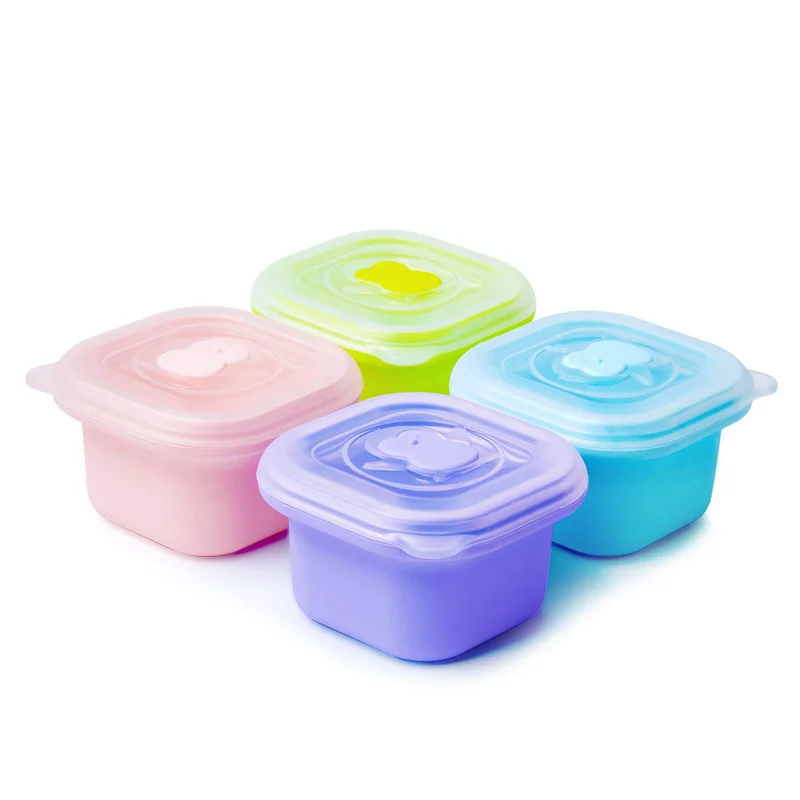
6. Wee Sprout Reusable Food Pouch
Best Food Pouches
Check Price
Does the idea of using food pouches for homemade baby food intimidate you? Many mamas feel that way, thinking a food pouch is something only hip food companies use. However, we think they are an excellent tool for helping children feed themselves and gain some independence.
This double-zippered pouch was designed to make the process easy. The best part is the extra-wide zipper opening on the bottom. Simply unzip the bottom, pour the food in, and seal it.
Because the space to fill it is so large, you don’t have to worry about making a mess when filling it up. One of the biggest concerns we have with food pouches is having food get stuck inside them, but the unique zip-open feature allows water to run right through it, so clean up is a snap.
Pros
- Extra-wide, double-zippered bottom.
- Eco-friendly materials.
- Multiple sizes available.
Cons
- Zippers can be hard to seal.

7. Collapsible Silicone Food Storage Containers
Best Large Baby Food Containers
Check Price
If you are a mama who makes baby food in bulk, a large container will save you time. Instead of carefully portioning everything you’ve made into multiple tiny jars, you can put it all in one large container and portion the food out.
These collapsible silicone containers from Wamery are best for baby food storage because they work for many situations. The largest container expands to hold up to 40.5 ounces, but you can convert them to whatever size you need.
The amount of food you need to make may vary depending on your baby’s appetite, health, and growth rate. Use these containers to hold whatever amount of baby food you choose to make, and then store them away easily when you’re done with them.
Pros
- Three large sizes to choose from.
- Collapsible design.
- Airtight lids.
- Made of easy-to-clean silicone.
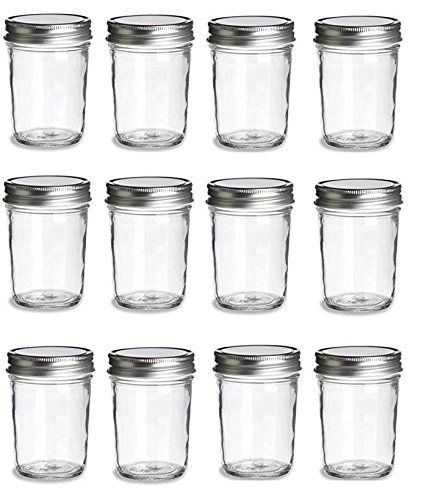
Cons
- Not designed specifically for baby food.
- No space to mark expiration dates.
Types of Baby Food Storage Containers
There are many types of baby food storage containers available, each designed to help moms. Here is an overview of the types of containers available and some of their benefits.
Glass Baby Food Containers
Glass is a popular choice for baby food jars for a reason. Glass is easy to sterilize, and you don’t have to worry about chemicals leaching into your baby’s food.
Baby Food Storage Jars
While baby food containers come in many shapes and sizes, jars are perfect for those looking to store small amounts of food they can easily carry with them.
Freezer Trays for Baby Food
Do you love making homemade baby food? Then you’ll appreciate the convenience of freezer trays. Freezer trays allow you to make and store homemade baby food for a long time without any hassle.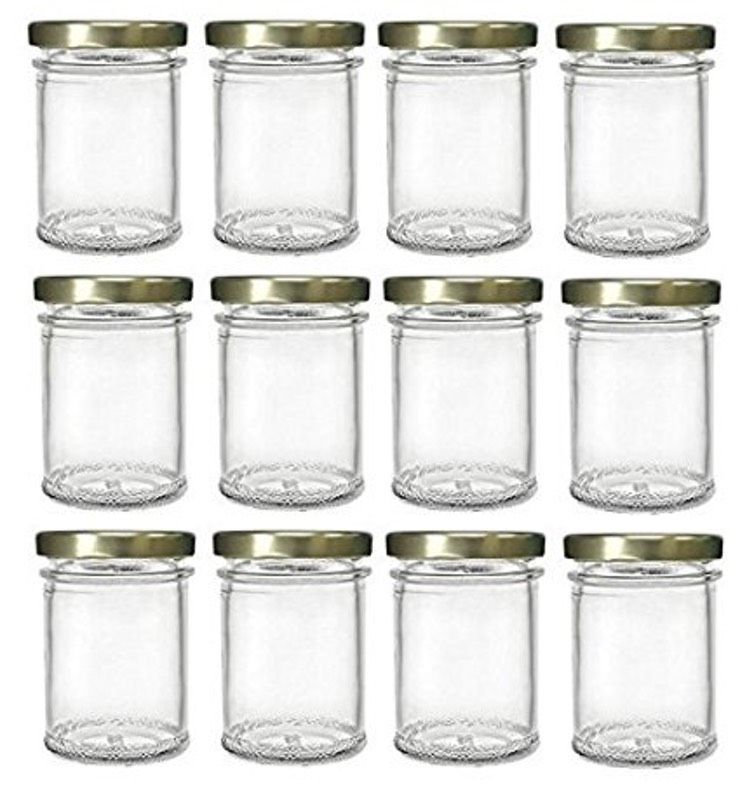
Plastic Containers
Plastic containers are more affordable for moms on a budget. However, you will want to look for plastic containers that are free of BPA and other harmful chemicals.
SnapLock Containers
SnapLock containers are designed for heavy-duty storage and longevity. Food stays fresh thanks to the airtight and waterproof seal.
Food Pouches
Food pouches are fun for both children and adults. Just squeeze and go! Most food pouches don’t require refrigeration, and children can use them to feed themselves.
Large Baby Food Containers
Sometimes you need to make a lot of baby food at once. Large storage containers can help you keep it all contained without spoiling it.
How to Store Baby Food Safely
You don’t have to be a food science expert to figure out how to store baby food safely.
Just follow these six tips (2):
- Never dip a spoon directly into the baby food storage jar: If you dip your baby’s spoon into a jar of baby food, put it into your baby’s mouth, and then place it back in the jar, saliva has now contaminated your baby food.
 If your baby does not finish a jar of food with saliva in it, you should throw it away. The bacteria in the container will continue to grow during storage, causing the food to spoil. Instead, open the jar, pour a little food into a bowl, and feed your baby from that.
If your baby does not finish a jar of food with saliva in it, you should throw it away. The bacteria in the container will continue to grow during storage, causing the food to spoil. Instead, open the jar, pour a little food into a bowl, and feed your baby from that. - Never leave food out for more than two hours: Once a jar of baby food has been opened, you can safely leave it out on the counter for up to two hours at room temperature. After that, bacteria can grow, especially if it is hot and humid. To be safe, we suggest never leaving opened baby food jars out on the counter. Always refrigerate them!
- Opened baby food jars last up to 3 days in the fridge: Make sure you keep the lids on tight and no saliva has gotten into the baby food. Even if it hasn’t been three days and the baby food looks or smells questionable, throw it out.
- Freeze baby food for up to eight months: The amount of time you can store baby food in your freezer depends on what type of food it is.
 Anything with meat or eggs in it can be frozen for up to two months, while fruits and vegetables can last up to eight months. Homemade baby food you’ve pureed yourself generally lasts between two and four months in the freezer.
Anything with meat or eggs in it can be frozen for up to two months, while fruits and vegetables can last up to eight months. Homemade baby food you’ve pureed yourself generally lasts between two and four months in the freezer. - Wash your storage containers thoroughly: No matter what type of storage container you use, wash it carefully with hot soap and water. Food that is stuck inside can spoil and mold.
- Write dates on the jars: Keep track of when you have bought, made, or opened a baby food jar by writing the date on the jar. Many jars come with a spot for a date and time, or you can purchase labels and stickers.
Storing Homemade vs. Store-Bought Food
Do you like to make your own baby food at home? Many moms do. It can be a more affordable, healthy option than factory-made baby food.
However, there are a couple of differences between storing baby food you make at home and baby food you buy in the store.
Most importantly, you need to keep everything clean (3). This includes your storage containers, all utensils, and your countertop space. It is also essential you wash your hands before and after the food-making process.
This includes your storage containers, all utensils, and your countertop space. It is also essential you wash your hands before and after the food-making process.
The shelf life of homemade baby food is also generally shorter than that of unopened store-bought baby food. This is because homemade food uses fresh ingredients and contains no preservatives. As a general rule, you should store homemade baby food for as long as you would an opened jar of store-bought baby food.
Making Your Own Baby Food
There are a lot of benefits to making your own baby food. You can control the ingredients and the portion sizes and save some money.
However, a new mom making baby food for the first time can be easily overwhelmed by the process. Did you use the right ingredients? How long will it last? Will your baby hate it and end up throwing most of it on the floor?
We don’t have all the answers, but we think every mom should give it a try! The journey will be one of exploration and experimentation. But it can become a fun experience and a deeper way to feel connected to your child as you move on to the next stage of feeding and begin introducing different foods into their diet.
But it can become a fun experience and a deeper way to feel connected to your child as you move on to the next stage of feeding and begin introducing different foods into their diet.
The Bottom Line
The WeeSprout Glass Baby Food Storage is our pick as the best baby food storage container as they come with everything a mom needs for making and storing her own baby food. Life is hectic enough, and WeeSprout’s simple system of glass jars with airtight lids helps alleviate stress and keeps you and your little one happy.
If you can store your baby food safely in the best storage containers, a new world opens up for you to explore. Taking care of your child by making homemade baby food can be a delightful experience.
Feedback: Was This Article Helpful?
Thank You For Your Feedback!
Thank You For Your Feedback!
What Did You Like?
What Went Wrong?
How to store expressed breast milk
If a nursing mother creates a breast milk bank for her own needs, she chooses the containers that are convenient for her. If we are talking about expressing and freezing donor breast milk, then the issue of packaging is a matter of bilateral agreement. Storage containers should be comfortable for the breastfeeding mother and comfortable for the host family at the same time, as they may have their own ideas about this. In most cases, the container is provided by the host family, so it makes sense to discuss this issue before starting cooperation on the exchange of donor breast milk. nine0003
If we are talking about expressing and freezing donor breast milk, then the issue of packaging is a matter of bilateral agreement. Storage containers should be comfortable for the breastfeeding mother and comfortable for the host family at the same time, as they may have their own ideas about this. In most cases, the container is provided by the host family, so it makes sense to discuss this issue before starting cooperation on the exchange of donor breast milk. nine0003
- In freezer bags for fruits and vegetables
These bags are sold in supermarkets and hypermarkets. They are specially designed for freezing food, they are certified, so they do not release any substances into the food, they are strong enough and with a reliable latch so as not to tear or open during storage (of course, if these are high-quality freezer bags). Since the daily portion of donor milk rarely exceeds the volume of 200 ml, so that it is not “lost” in the bag, it is better to use packages of the minimum volume that are on sale. nine0003
nine0003
- In clean baby food jars
If a mother buys industrial baby food for her child, sometimes a large stock of these jars accumulates in the house. They come with a well-closing lid, and the glass itself is inert and great for long-term storage. Jars must be thoroughly washed before use. Also, do not forget the old trick with a bursting frozen full jar, so you need to freeze the jars not completely filled so that milk, like any liquid, has a place to expand. Glass jars are also convenient because they are reusable. When the milk from the jar is eaten, it can be washed and reused to store the next portion. The disadvantage of jars is that they take up a lot of space in the freezer. nine0003
- In sterile test jars
Sterile test jars are available in pharmacies. They are small, they have a measuring scale in milliliters, which is convenient for determining the amount of milk in a jar. According to the terms of their intended use, it is assumed that such jars can be cooled and frozen, therefore they are made of inert plastic, which does not release anything when cooled and frozen. Such jars take up less space in the freezer than the previous ones, but still more than soft plastic bags. nine0003
Such jars take up less space in the freezer than the previous ones, but still more than soft plastic bags. nine0003
- In ice packs
Although such packs are not convenient for everyone, some mothers adapt not to defrost the entire pack at once, but to carefully cut off a few cubes from it and defrost exactly the small portion that is needed for feeding. When using such bags, you need to pay special attention to their strength, as they are often made of very thin plastic, and they tear easily.
- In any strong bag or container intended for food storage
In principle, breast milk is the same food for the baby as the rest of our food, so any containers designed for cooling and freezing food are suitable for storage. It is only necessary not to forget about the general rules of hygiene.
- In sterile bags used by the food and biological industries to store samples
made of durable and inert plastic. nine0003
- In special bags for breast milk
Manufacturers of goods for children offer us this option. They are small, as a rule, with a marking in the form of a scale that allows you to determine the amount of milk in the bag. But these packages are of different quality even from the same manufacturer, and, despite their high cost, according to mothers, it happens that they are torn and opened during storage.
They are small, as a rule, with a marking in the form of a scale that allows you to determine the amount of milk in the bag. But these packages are of different quality even from the same manufacturer, and, despite their high cost, according to mothers, it happens that they are torn and opened during storage.
- In special breast milk containers
This is the most expensive storage container option and is significantly more expensive than even special bags. These containers are strong enough that they do not crack, but they can leak if the lid is screwed loose or askew, which is easy to do in a hurry. And they take up more space in the freezer than all the previous options. The advantage of this option is that the containers are reusable, they, like baby food jars, can be washed and used again.
No container for breast milk increases or reduces its shelf life. When choosing any container option, it is necessary to follow the rules of hygiene and carefully monitor the safety of the container during storage and defrosting, since losing even 100 ml due to the fact that the bag burst is very disappointing.
If you choose any rigid plastic containers, you need to make sure that they do not contain BPA. nine0003
Freezing Homemade Baby Food Encyclopedia Baby Food
Levchuk Viktoria©
There are some important guidelines for freezing baby food that you need to follow, they are outlined on this page, and there is even a diagram of the foods that can be frozen. We will show you how to freeze freshly made puree and store it. It will be interesting to read.
Good to know!
- Frozen baby food leftovers - what to do with them, we will find out in the article.
- Heading Frozen food - all about baby food cubes.
- New thinking on allergens
Easy to use sitemap Encyclopedia Baby Food with a list of all articles and recipes.
How long do you keep baby food in the refrigerator or freezer?
Contents:
- Freezer: 4-6 months (ideally used within 1 month or 3 months)
- Refrigerator (fruit/vegetables): 24 hours
- Refrigerator (meat, poultry, fish eggs): 24 hours
For optimum quality and nutrient retention, store frozen baby food cubes in the freezer within no more than 1-3 months.
Frozen baby food is safe to use if kept in the freezer for about 3-6 months without thawing again. However, it is more reasonable to use them in the region of 1 month to 3 months inclusive. Due to the amount of water crystals that accumulate in baby puree, and the fact that nutrients and important substances can be leached/evaporated when thawed due to these same water crystals, it is wiser to use your frozen baby food whenever possible. - no more than 3 months of storage. However, it is best to use within the first month after freezing, we advise. nine0003
Most sources advise storing fruit and vegetables for 8 to 12 months in the freezer. This is mostly true of whole foods that are congealed in their natural state. This is also provided that the refrigerator compartment remains at a constant temperature below zero. Deep-freezing is best if you want to keep frozen food for a long time. However, it should be remembered that the instructions and recommendations for freezing food for long-term storage do not imply that the fruit or vegetable has been boiled and mashed.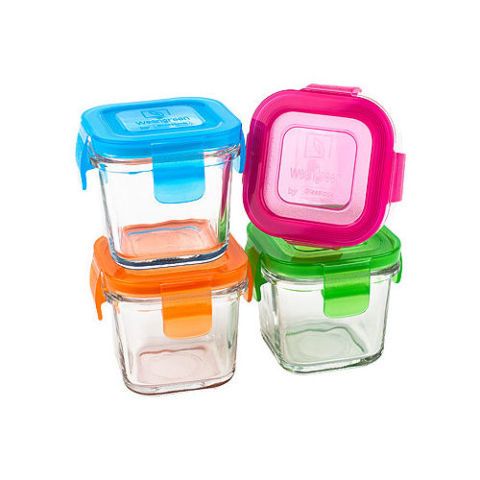 nine0003
nine0003
How long can baby puree be kept in the refrigerator?
In the refrigerator, it is not recommended to store fresh pureed homemade baby food for more than 24 hours. This limitation ensures that the growth of pathogens in the puree is kept to a minimum and that the food does not take on the “refrigerator flavor”. This "rule" applies to vegetables, fruits, meats, etc.
If it is not planned to freeze homemade baby food, then baby food for the baby is prepared every day if he is too small until 8-9months, or every other day, older than the specified age.
Why freeze baby food?
Save parent time, reduce food waste and ensure food safety.
For example, one potato was baked in the oven, and then the half was mashed and the other half was frozen.
Frozen vegetables or fruits are safe in baby food
Fruits and vegetables can be frozen. Using frozen fruits and vegetables is the second best option after eating fresh. The quick freezing process (food is frozen at a very low temperature and very quickly) actually preserves the nutrients optimally. Cooking destroys more important nutrients than freezing food. Contrary to myth, freezing food (particularly fruits and vegetables) does not destroy 100% of minerals and vitamins. The freezing process, subject to storage conditions at a constant temperature of zero degrees, does not contribute to the complete loss of nutrients and important substances - if this is the case, then most of the population is malnourished, since in winter we eat a huge amount of frozen foods. nine0003
The quick freezing process (food is frozen at a very low temperature and very quickly) actually preserves the nutrients optimally. Cooking destroys more important nutrients than freezing food. Contrary to myth, freezing food (particularly fruits and vegetables) does not destroy 100% of minerals and vitamins. The freezing process, subject to storage conditions at a constant temperature of zero degrees, does not contribute to the complete loss of nutrients and important substances - if this is the case, then most of the population is malnourished, since in winter we eat a huge amount of frozen foods. nine0003
Frozen vegetables not cooked at the time of packaging must be cooked before eating. Please remember to read the labels of frozen bags, as some brands of frozen vegetables may be pre-cooked.
One of the most frequently asked questions is "Can I use frozen fruits or vegetables for baby food and then freeze the puree?". Since there are no studies that show that repeated freezing is negative and / or can negatively affect health. The problem is that it is necessary to cook food from products that have been frozen once. But the reality is that a frozen product, going through all the stages from a fresh look to a frozen product in a refrigerator in a store, can survive several defrosting and freezing, as it was written earlier, it is through water crystals that nutrients leave. Therefore, purchased frozen vegetables and fruits must be carefully selected, and we would not recommend preparing baby food from them for subsequent freezing of baby puree. It is clear that sometimes parents have no choice and have to start complementary foods with purchased frozen food, so we carefully choose the packaging and the manufacturer, without holes, without pieces of ice. nine0003
The problem is that it is necessary to cook food from products that have been frozen once. But the reality is that a frozen product, going through all the stages from a fresh look to a frozen product in a refrigerator in a store, can survive several defrosting and freezing, as it was written earlier, it is through water crystals that nutrients leave. Therefore, purchased frozen vegetables and fruits must be carefully selected, and we would not recommend preparing baby food from them for subsequent freezing of baby puree. It is clear that sometimes parents have no choice and have to start complementary foods with purchased frozen food, so we carefully choose the packaging and the manufacturer, without holes, without pieces of ice. nine0003
For example, from frozen vegetables (home-made or a good quality store-bought bag) that were raw when frozen, we cook a roast, we freeze the leftovers of the roast and use it for its intended purpose next time, but it is not worth freezing the roast after the last defrosting.
Why not refreeze
Do not refreeze thawed food, this is a correct statement. Re-freezing a defrosted product can affect the quality and taste (and possibly nutritional value) of the product, and when it is thawed, pathogenic bacteria may begin to multiply. It is always necessary to prepare defrosted food before re-freezing. The preparation of a thawed product then allows it to be re-frozen in a single cycle. Storing a bag of frozen fruits or vegetables makes food preparation a quick and easy solution. You do not need to defrost the whole package, just get the required amount of the product, and leave the rest in the freezer. nine0003
The easiest way to freeze baby puree is to spread it with a spoon in an ice mold, cover with plastic wrap so that there is no air access.
Before using the ice molds, they must be thoroughly cleaned with soap and boiled water. Some parents even immerse their ice molds in boiling water for sanitization (Note: Make sure the sanitization is suitable for the molds before use. )
)
There are many benefits to storing your child's homemade food in an ice mold:
- Each cube is approximately the same size, which allows parents to determine the amount of food the child consumes.
- Minimal waste when using only 1 cube at a time and not having to throw away a lot of food.
- Another advantage is that the ice molds are close at hand and you don't have to go out and buy them.
- The time spent in the kitchen is significantly reduced.
You can transfer baby puree cubes to freezer bags, freeing up molds for the next batch of food and also freeing up some freezer space. nine0003
Do not forget about the marking of packages with cubes of baby puree, write the date of freezing and the type of puree. This will help you quickly remove the cube from the package, as well as monitor their expiration date.
Ice crystals on baby food cubes
Don't worry if ice crystals are visible on baby food cubes. It's not frostbite, but excess liquid used in mashing that rises and solidifies at the top of the cubes. These crystals or frost are not dangerous and will not make baby puree cubes inedible or harmful. nine0003
It's not frostbite, but excess liquid used in mashing that rises and solidifies at the top of the cubes. These crystals or frost are not dangerous and will not make baby puree cubes inedible or harmful. nine0003
Frostbite - what is it and how to determine it?
Frostbite looks like greyish brown spots on frozen food. It looks like a leathery type of texture and is easily noticeable. Crystals on frozen foods are not frostbite, but are the result of excess liquid during the freezing process and the formation of ice crystals.
Frostbite does not make frozen foods bad or harmful; it just makes the affected areas very dry. The only thing that can suffer in food that is frostbitten is the quality. You can cut off frostbitten areas and use the undamaged area of food. Frostbite is the result of excess air in a frozen bag that sinks onto food. Eliminate air pockets in bags to help stop frostbite. nine0003
Can glass baby food freezer jars or baby food jars like Frutonyanya or Gerber be used? and also such banks are prone to rupture.
 Baby food jars are not manufactured for freezing or extreme heating. There are glass jars for freezing food in them, but they can be hard to find. Many people freeze in baby food jars, but I'm not a fan of this at all. After all, food is made for the baby because we want to give him the best healthy food; Do you really want to take the risk and freeze baby food in glass jars? nine0003
Baby food jars are not manufactured for freezing or extreme heating. There are glass jars for freezing food in them, but they can be hard to find. Many people freeze in baby food jars, but I'm not a fan of this at all. After all, food is made for the baby because we want to give him the best healthy food; Do you really want to take the risk and freeze baby food in glass jars? nine0003 There are certain plastic jars that are specially made to withstand high temperatures and/or freezing. Therefore, it is best to use plastic containers or ordinary thick plastic bags, convenient and simple. There are also special freezer bags with a zip clip - an interesting option.
Can previously frozen breast milk or formula be used to make vegetable or fruit purees?
Do not use previously frozen breast milk to prepare puree to freeze this baby food.
Breast milk should never be re-frozen in any shape or form.
Milk formula
You can freeze puree to which thawed milk formula has been added. However, formula should not be frozen in bottles or cans. It is impossible to add the mixture to the previously frozen mixture and freeze it. If frozen milk formula is used for mashing, then it is necessary to freeze it at a time without defrosting. Freezing milk formula causes separation of fats and liquids, and the texture suffers accordingly. Although there is no health risk, the same happens with breast milk and cow's milk, the texture and quality suffer a little. However, it is best to prepare the milk formula before putting it in the baby puree and only then freeze the puree. This will be more useful and efficient. nine0003
However, formula should not be frozen in bottles or cans. It is impossible to add the mixture to the previously frozen mixture and freeze it. If frozen milk formula is used for mashing, then it is necessary to freeze it at a time without defrosting. Freezing milk formula causes separation of fats and liquids, and the texture suffers accordingly. Although there is no health risk, the same happens with breast milk and cow's milk, the texture and quality suffer a little. However, it is best to prepare the milk formula before putting it in the baby puree and only then freeze the puree. This will be more useful and efficient. nine0003
Some formula manufacturers say that freezing any formula is not recommended, as the process can alter physical properties such as fat separation, which can be difficult for sensitive babies to digest. Freezing does not affect the quality or food sterility, however it will not prolong the shelf life of formula. Freezing may result in the loss of the desired appearance and functionality and is therefore not recommended.